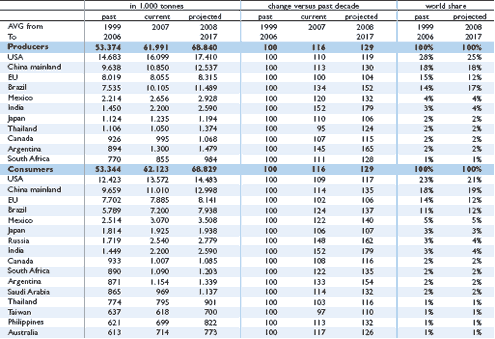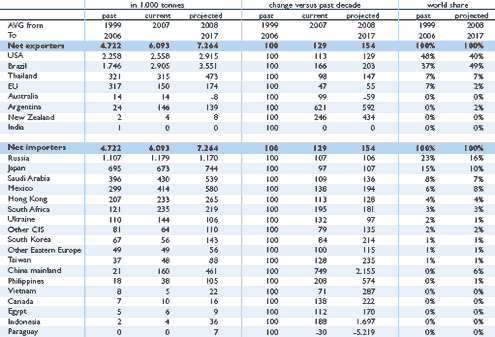



Prospects for Poultry Markets in the EU and Globally: 2008 – 2017
AVEC, the Association of Poultry Processors and Poultry Trade in the EU Countries, has published its annual report for 2008, which includes an overview of the projections from various international agencies on the production of poultry meat in the European Union and also projected trade between leading exporting and importing countries.
The data presented in the article come from a comparative analysis of projections published by OECD/FAO – FAPRI and USDA published on the web site of the Directorate General of Agriculture and Rural Development in July 2008. FAPRI and USDA projections are less comprehensive than the OECD-FAO since they do not publish results for world meat consumption, production and trade, but simply consider a limited number of major players. Furthermore, FAPRI and USDA do not cover the entirety of the meat sector, since they lack sheep meat and, in the poultry sector, FAPRI misses data about turkey.
However, by summing up figures for the major countries and commodities considered respectively by FAPRI and USDA, one can obtain a proxy for the global meat sector. In such a way, the corresponding projections of OECD-FAO, FAPRI and USDA can be compared, although only in terms of trends rather than in absolute values. Nevertheless, the different analytical approach and degree of coverage achieved by the three organisations, jeopardise the full comparability of the results and makes it sometimes difficult to find a precise justification for differences in results.
Recent Developments
In the coming decade, the meat sector as a whole will continue its long-term rising trend driven by world population growth and economic development, particularly in developing countries. The growth for the poultry and pork sector (+2.0 per cent per year) is only slightly higher than for sheep (+1.8 per cent) and beef (+1.7 per cent).The current relative share of the three main meat categories is supposed to remain relatively stable until 2017.
The poultry sector was the most dynamic meat sector during the reference period (1999-2006). It displayed the largest growth of world consumption and production of all meat categories. At global level, total poultry consumption and production (all species) increased from 66 million tonnes in 1999 to 83 million tonnes in 2006, corresponding to an annual increase of 3.2 per cent. These results were attained despite recurrent consumers' scares and regional trade restrictions linked to the spread of various diseases, such as the outbreak of avian influenza, which represented a major threat for the poultry sector worldwide.
Global Consumption and Production Forecasts
In general, poultry consumption not only boomed in developing countries, but also showed, as the only type of meat, a significant positive trend in developed countries. Therefore, the increase in world poultry consumption was shared, contrary to beef and pig meat, more evenly among various countries: the USA account for 15 per cent of the global growth, followed by China with 13 per cent, Brazil with 9 per cent, the EU with 8 per cent, India with 7 per cent and Mexico and Russia with 6 per cent. Considering the different size of the various markets, the highest annual growth rates of poultry consumption during the reference period were registered in India (+13.1 per cent), Mexico (+6.4 per cent), Russia (+6.1 per cent) and Brazil (+4.0 per cent).
On the production side, the most remarkable growth rate among the main poultry producing countries was attained by Brazil (+7.1 per cent per year), while for the other three world leaders (USA, China and the EU) the pace of the growth was more modest. In other terms, Brazil can be attributed 20 per cent of the increase in world poultry production between 1999 and 2006, against the 15 per cent of the USA and the 13 per cent of China. This data show that Brazilian poultry production has considerably increased its export vocation during the recent past. As for the other meat sectors, the prospects of OECD-FAO, FAPRI and USDA regarding the development of poultry production, consumption and trade are quite similar: they all expect a growth of around 30% for the poultry sector and an even stronger increase for the relevant global trade flows. In the case of poultry, the comparison of the different outlooks might be biased by the fact that FAPRI data on poultry, contrary to OECD-FAO and USDA, are limited to chicken, i.e. do not consider turkey.

(Source FAPRI)
Poultry Meat Trade Forecasts
FAPRI projections hint to a sharp growth in Brazilian net exports of chicken, which are expected to roughly double on average between 1997-2006 and 2008-2017 (from 1.7 million to 3.6 million tonnes per year). Brazil would then account for almost 50 per cent of the world trade, thus clearly overtaking the USA as the world export leader, although USA chicken exports also increase by almost 30% between the reference period and the next decade. This development is exactly expected also by OECD-FAO.
The projections of the two institutes also match on the rankings of the next decade's most important chicken net importers of the world (Russia, Japan, Saudi Arabia, Mexico and China, in the order). However, while there is agreement on a strong growth of imports in the latter three countries, the opinion diverges with respect to the development of imports in the top importers Russia and Japan: FAPRI forecasts a moderate growth of imports during the projection period, while OECD-FAO outlook predicts a slight decline.

(Source FAPRI)
As to the importing countries, the annual growing rates of poultry imports are destined to decline for all the main players. Nevertheless, it is worth mentioning that according the OECD-FAO outlook the EU is expected to attain progressively, during the projection period, the status of poultry net importer. However, for FAPRI the EU should still remain a slight net exporter.
Further Reading
| - | You can view the full 2008 Annual Report from AVEC by clicking here. |
January 2009








